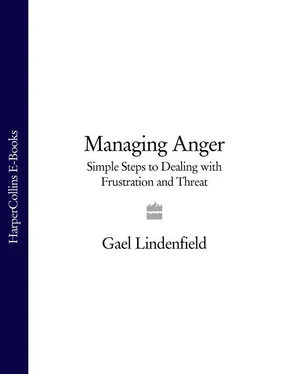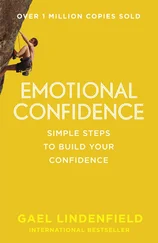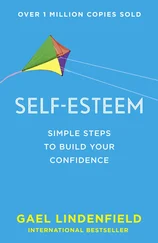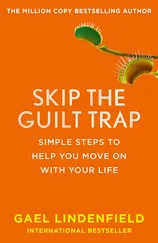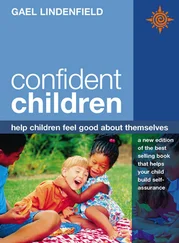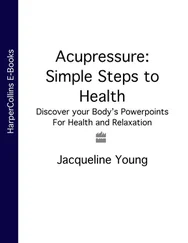When, in my thirties, I experienced another major personal crisis in the shape of a marriage breakdown, I became even more aware of how my inability to handle my anger was hurting not just me, but my children as well. So once again I began to strangle and repress it, with the result that my physical health suffered almost disastrously. Luckily, however, in the course of my search for additional professional stimulation (to dull my personal pain), I discovered Assertiveness Training. At last I found a method of help which actually gave me alternative strategies to use in order to help me cope with my own and other people’s negative feelings. Motivated largely by my own personal needs, I began to adapt and expand the ideas of AT and integrate them into my counselling and self-help work. Using also my knowledge and experience of other therapies such as Transactional Analysis, Gestalt and Dramatherapy, I then began to formulate my own strategies under the heading of Assertive Anger.These became further tried and tested as I began to run courses on this specific subject.
More recently, I have become very aware that the mismanagement of anger is not just a problem for the small minority of people who may need the help of a therapist. As I began to expand my work outside the field of mental health, and specialize in helping with the more ‘everyday’ problems which face the majority of us in the daily course of our lives, I found that almost everyone I met seemed to have some degree of difficulty in handling anger!
Is this a problem of our age, I wonder? Many therapists and counsellors are beginning to think it could be and that, judging by the behaviour of many young people, there could be worse to come. The Director of the Samaritans in Great Britain has cited depression, resulting from unexpressed anger, as one of the most likely causes for the alarming rise in teenage suicides. Similarly, other professional social observers of the young are often heard to blame a build up of anger for the frightening outbreaks of riots and hooliganism.
If the problem is so widespread, we should all be very concerned because, as a society, it seems we have never been in greater need of the positive power of anger and, never under greater threat should this emotion be mismanaged. Mass anger about the injustices in our world and about the threats to our precious planet is, in my opinion, both appropriate and laudable. We should welcome it, because it could help motivate us to preserve what we value. However, if it is allowed to turn negatively inwards, it will weigh us down with disabling apathy and despair – and, if it is directed aggressively outwards, it could destroy us all.
While I am not suggesting that a change in the way in which we handle anger can be a cure-all for all the personal and social evils of the world, I do believe that it could dramatically improve very many people’s ability to cope with them. So in this book I have first explored some of the facts and fiction about anger, then introduced a model for managing it both positively and constructively. As I said earlier, I call this model Assertive Anger. A brief outline of its main features can be remembered easily by using the following mnemonic:
Assertive
Non-Violent
Goal-directed
Ethical
Responsible
The latter sections of the book offer practical guidance on ways in which we can work towards achieving this ideal!
In summary, the structure of the book is as follows:
Part 1: Understanding more about anger is the theoretical section of the book and is designed to help you to understand more about how anger affects our bodies, minds and behaviour. It also explains what the philosophy underpinning the model of Assertive Anger is all about. You will find that there is considerable emphasis on the damage and hurt which both the passive and aggressive methods of handling anger can cause. I hope this will motivate you to read on and complete the practical work in the rest of the book!
Part 2: Managing our own anger presents a six-step self-help programme which you can use to break old patterns and replace your conditioned responses with new behaviour. Through these exercises you can begin to learn how to express your anger without hurting yourself or others.
Part 3: How to deal with other people’s anger offers guidelines and exercises to help you take better control of your own feelings when faced with outbursts from others. It also suggests ways in which you can help other people safely unbottle some of their repressed anger, which may be damaging your relationships with them.
Part 4: Preventative strategies can help you plan ways in which you can alter your general patterns of behaviour and lifestyle, so that you can prevent a build up of unnecessary tension and frustration.
Part 5: Further reading gives a list of other books which may be of interest and help.
Who Can Be Helped by This Book?
I think this book will be of particular help and interest to people who:
– have already completed some personal development work which has given them an awareness of the difficulties they have with anger
– have persistent relationship difficulties and find it hard to resolve conflicts without hurting themselves or others
– are suffering from health problems or addictions which they have been told, or suspect themselves, may be being caused, or made worse by, their mismanagement of frustration and anger
– are living or working under high levels of pressure and need to take particular care with the management of their emotions
– are bereaved and finding themselves ‘stuck’ in their grief
– are struggling with mental health problems such as depression, phobias, obsessions and eating disorders
– are trying to help others manage their stress and anger more constructively, e.g. managers, training officers, teachers, community workers, counsellors, nurses and doctors – not to mention millions of concerned and harassed parents!
As I indicated earlier, the ideas in this book have arisen in the main from my own personal experience and my work with people on ‘everyday’ problems at home and at work. I am very aware that a minority of people’s problems are so severe that their needs cannot be completely met within the scope of a self-help book such as this. For example, I would urge anyone who is prone to serious outbursts of violence, or suspects that they could be, to seek additional help from a professional therapist or doctor.
Similarly I would suggest that anyone who is living or working with someone with such difficulties, or anyone who has suffered serious abuse in the past, should not hesitate to request further professional guidance. A list of helping agencies can usually be found in any good library, social services or health department, or through the many confidential phonelines that now exist to help people living or working under such stress and threat.
Ideally this book should be read slowly, over a period of a few weeks, so that its contents can be thought about in the context of the practical experience of living with the issues and problems which it addresses. Alternatively, you could give it a quick read through first and then re-read at a slower pace later, concentrating on the particular sections which are of interest to you.
With regard to the practical work, I feel that this should be undertaken step-by-step, in the order which I have suggested. I have found that good foundation work in any personal development programme makes the learning of new skills so much faster and more secure.
Читать дальше
